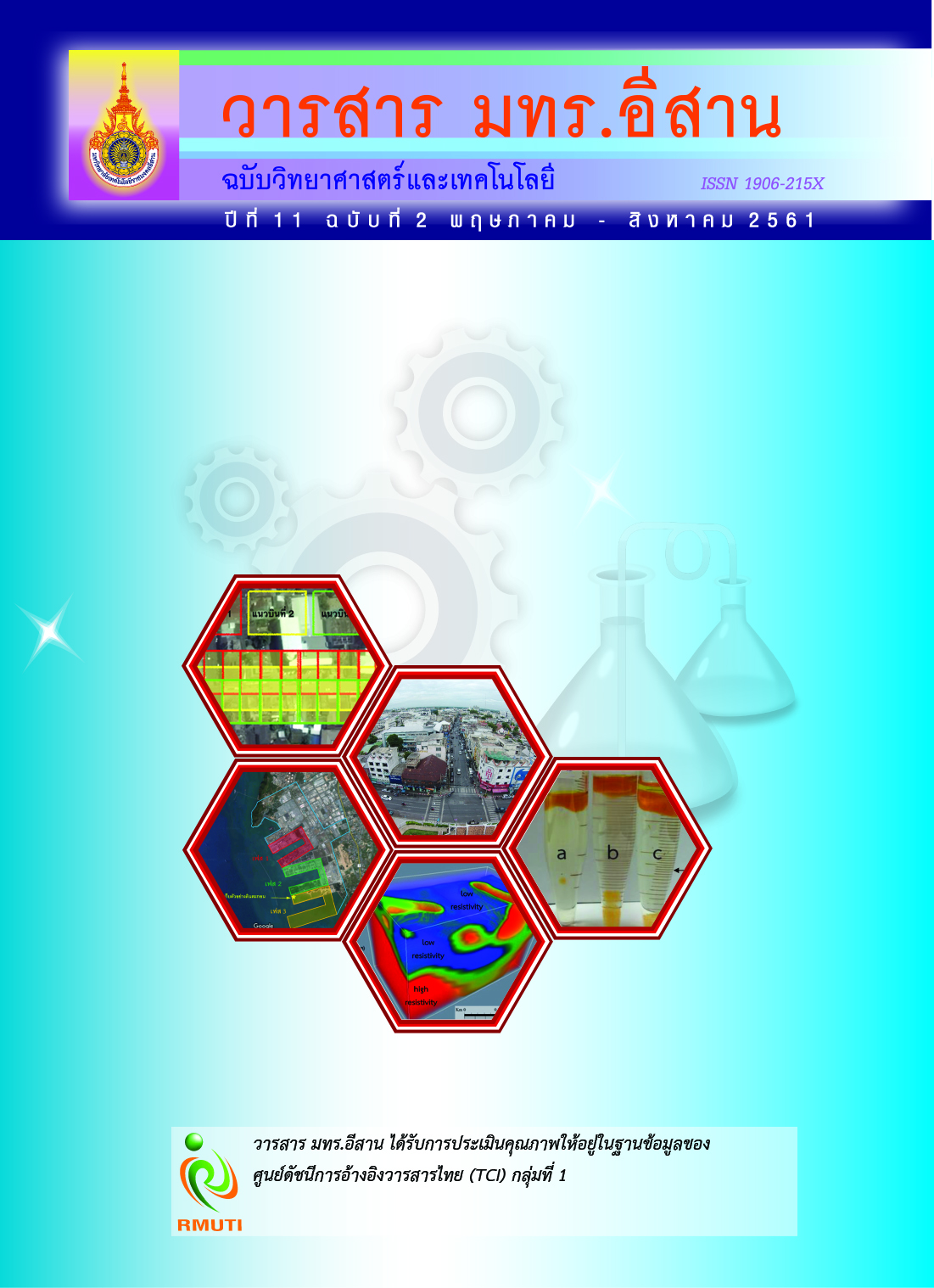Water Quality After Removing Shops at Klong Ong Ang
Main Article Content
Abstract
Klong Ong Ang is a historical canal in Bangkok. There were shops trespassing the canal over 30 years. It affected to drainage and water pollution, so Bangkok used law to remove the shops in 2015. Therefore, this research is for studying factors that affected to water quality of Klong Ong Ang viz. removing the shops, month and floodgate, and identifying type of surface water by studying water quality of the canal viz. color, odor, turbidity, dissolved oxygen (DO), biochemical oxygen demand (BOD), total coliform bacteria (TCB) and fecal coliform bacteria (FCB). We collected 3 times within 6 months. The collection was 2 times,
before opening and after closing Ong Ang floodgate. It was found that the 1 and 3 months-water samples were green, turbid, and odorless, while the 6 month-water was colorless, clear, and odorless. Moreover, DO was 3.12 - 5.49 mg/L, BOD was 4.39 - 14.03 mg/L, TCB was 1.95 x 105 - 1.95 x 106 MPN/100 mL, and FCB was 6.65 x 104 - 6.37 x 105 MPN/100 mL. Besides, DO and FCB were higher than those of before removing the shops in 1983, 1998, and 2012 at 0.05 significant level. DO was in standard level, while FCB was out of the level. WQI (Water Quality Index) was 24.01, so Klong Ong Ang should be surface water type 5 that can be used for only transportation following standard of surface water.
Article Details
References
[2] Dailynews team. (2015). Announcement of Water and Electricity Cut off to Seller at Saphan Lhek by using law of Revolutionary. Access (18 February 2016). Available (https://www.dailynews.co.th/bangkok/350205) (in Thai)
[3] Kent, M. (2014). How to Identify Pollution. Access (4 February 2016). Available (https://classroom.synonym.com/identify-pollution-22930.html)
[4] Rojjanaburanont, T. (1983). Study of Water Environment of main canal in Bangkok. Research Report. Bangkok, Chulabhorn Research Institute. (in Thai)
[5] Uawongsajja, W. (1998). Investigation of Water Environment in Banglumpoo-Ong Ang Canal. Senior Project, General Science Department, Faculty of Science, Chulalongkorn University, Thailand. (in Thai)
[6] National Statistical Office. (2002). Environment of Thailand in 2002 about Water Quality of Canals in Bangkok. Research report. Bangkok. (in Thai)
[7] Department of Drainage and Sewerage, Bangkok. (2013). Water Quality of Canels in Bangkok in 2012. Access (30 December 2016). Available (https://service.nso.go.th/nso/nso_center/project/table/files/1500901/2555/000/10_1500901_2555_000_000000_00100.xls) (in Thai)
[8] APHA - AWWA - WEF (American Public Health Association - American Water Works association - Water Environment Federation). (2005). Standard Methods for the Examination of Water and Wastewater. Access (10 March 2016). Available (https://www.standardmethods.org)
[9] Pollution Control Department. (2016). Calculation of General Water Quality Index: WQI. Access (21 December 2016). Available (https://iwis.pcd.go.th/index.php?method=calculate&etc=1533878670804) (in Thai)
[10] Hanmongkolpipat, P. (2004). Statistics and Experimental Design. 2nd edition. Kasetsart University Publisher, Bangkok. (in Thai)
[11] Royal Irrigation Department, Ministry of Agriculture and Cooperative. (2011). Study of Water Quality of Chaophraya River following Command of Queen Sirikit. Access (18 February 2016). Available (https://kmcenter.rid.go.th/kchydhome/documents/2554/article/sed012.pdf) (in Thai)
[12] Choo-in, S. (2012). Water Quality Management Klong Wat Rajathiwas, Dusit, Bangkok By Water Replacement. Research Report. Suan Sunandha Rajabhat University Bangkok. (in Thai)
[13] Onnom, R. (1997). Study of Water Quality and Effect of Dam Use in Bangprakong River. M.S. Thesis, Environmental Engineering, Faculty of Engineering, Kasetsart University, Thailand. (in Thai)
[14] System of Law Data of Water Management. (2016). Announcement of National Environmental Council. Access (10 July 2016). Available (https://hydrolaw.thaiwater.net/web/) (in Thai)
[15] Riyakan, I. (2013). Wastewater Treatment by Effective Microorganism Ball: A Case of Study of Wastewater Sample from Sansab Canal. SDU Research Journal. Vol. 6, No. 2, pp. 153-168. (in Thai)
[16] Salab, K. (2017). Chiang Mai Water Disaster The Director General of the Pollution Control Department Has to Manage the Water System, Resolving Problems of Mae Kha Canal and Moat. Access (21 June 2017). Available (https://www.tnews.co.th/contents/318342) (in Thai)
[17] Chiratthiti, C., Sakulkaew, K., Pinijwejchakarn, S., Yookongkarm, S., Langla, D., and Kaewkiaw, A. (2016). The Study of Health Affected by Bacterial Water Quality of Chao Phraya River. Access (30 December 2016). Available (https://bkkthon.ac.th/home/user_files/department/department-24/files/8-57.pdf) (in Thai)


